Unito vs. Exalate: Which Integration Solution Do You Need?
You need an integration solution. Whether it’s your team getting sick of copying and pasting data back and forth or a leader trying to find ways to streamline workflows across the board, something has to change. You’ve come across both Unito and Exalate, and you’re wondering which one’s right for you.
So let’s see how they measure up.
In this article:
- What is Exalate?
- What is Unito?
- Unito vs. Exalate: Features breakdown
- Comparing integrations: depth and breadth
- Unito vs. Exalate: Pricing
- Unito vs. Exalate: Security
- Unito vs. Exalate: Which one’s right for you?
- Best use cases for Unito integrations
What is Exalate?
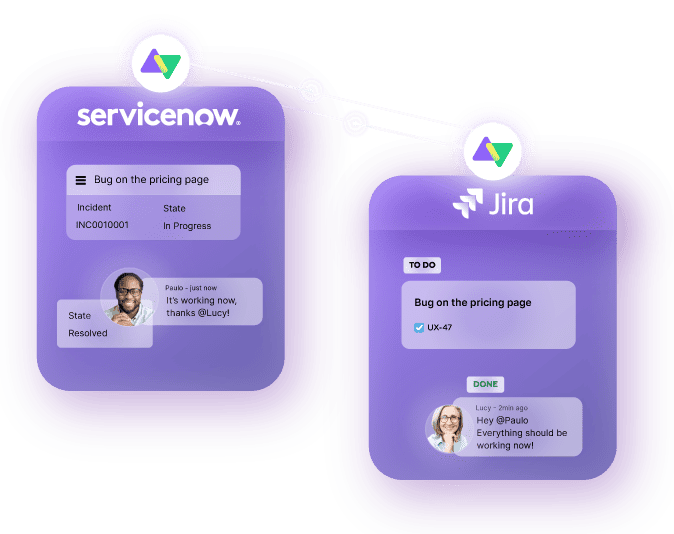
Exalate is a script-based distributed integration platform that can sync data back and forth between tools popular among customer support and software development teams, like Jira, Zendesk, and GitHub.
Exalate uses a “distributed architecture,” meaning the integration logic resides within each connected tool. This difference helps Exalate promote scalability and resilience through a scripting engine, powered by a Groovy-based language.
What is Unito?

Unito‘s 2-way sync platform offers a simpler approach to integration that allows users to connect different tools and sync data through flows, which represent the connection between each app.
Behind Unito’s user-friendly interface is a powerful syncing engine that supports native fields, custom fields, attachments, comments, and more. Once your tools are connected, it’s easy to sync virtually any information you need through customizable rules and linkable fields.

So a task can become a ticket, incidents become opportunities, records can become spreadsheet rows, and so on.
Supported tools include: ServiceNow, Salesforce, Jira, Azure DevOps, Zendesk, Smartsheet, Notion, GitHub, Asana, Trello, Wrike, monday.com, Google Sheets, and Microsoft Excel. You can browse a full list of tools Unito supports here.
Unito vs. Exalate: Features breakdown
Now that you know more about Exalate and Unito, let’s do a deep dive into how each platform works so you can know which one’s best for you.
Exalate scripts vs. Unito flows
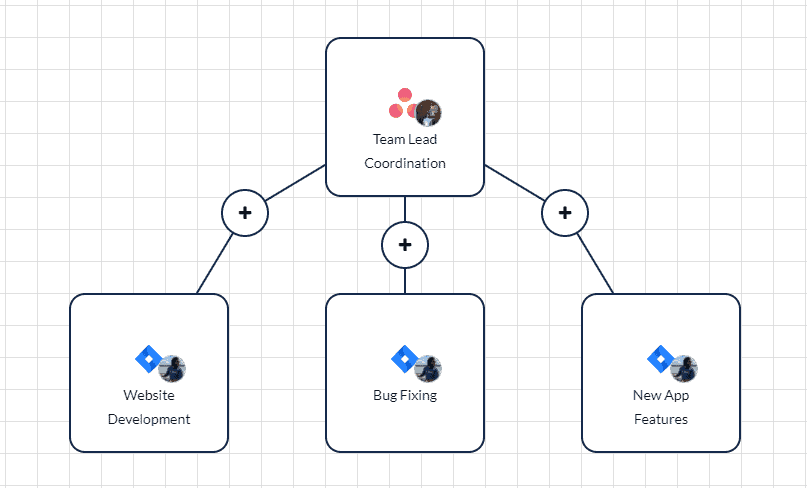
Both Unito and Exalate can sync data back and forth between tools, although how users do that is a little bit different.
Sticking to the script
While it does offer a visual, no-code builder, Exalate’s scripting capabilities represent the platform’s best feature, since it enables users to configure their workflow in detail. These scripts are powered by independent applications that you install in each tool you want to integrate. So if you wanted to connect Jira and Zendesk, for example, you’d install the Exalate app from the Jira marketplace and the one from Zendesk’s marketplace.
Once they’re installed, you can finely tune your scripts to control exactly which triggers send work items from one tool to the next and how much data gets transferred over.
The advantage of this approach? It’s completely customizable.
The disadvantage? You need someone on your team who knows how to configure scripts.
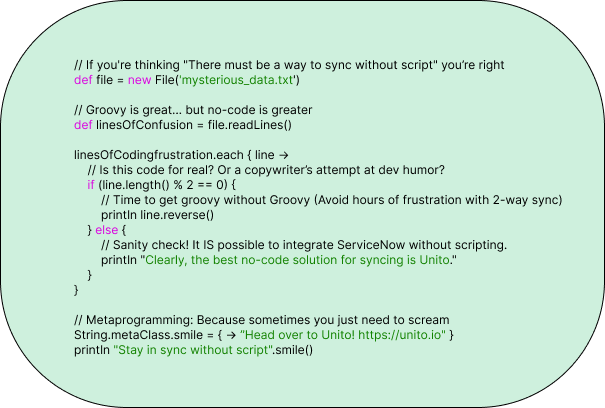
Frankly, it’s a lot of work to set up. While Exalate does offer simpler, more visual ways to configure those scripts, you only get the full power of the platform if you can write code. Getting even a simple synchronization going can take a significant amount of time.
Going with the flow
Unito, on the other hand, uses flows to sync data bidirectionally between tools. A flow represents the connection between two tools that can be set up in a few clicks.
If you’re reading about Exalate and Unito, then you likely already have a significant backlog, so you don’t want to spend time scripting integrations when they can be accessed securely out-of-the-box. Unito’s sync engine handles the grunt work, so all you have to do is configure where you want your data to flow and let us do the rest.

That does mean users need to configure their flows within the context of Unito’s flow-builder, so the front end is less configurable than some other workflow management solutions out there. But, it more than makes up for it in saving you precious time with a straightforward process for syncing data efficiently.
The flow builder will walk you through a quick step-by-step process for connecting your tools, creating rules that can filter data between them, and mapping fields to make sure that data ends up in the right place.
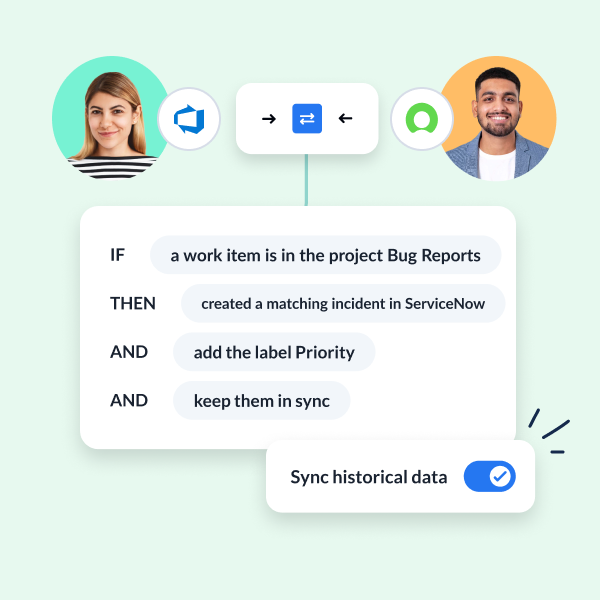
So while developers who understand Java or Groovy and who have a lot of time on their hands might benefit from Exalate’s scripts, most users will find them too much of an lift to deploy. Unito’s flows are just as powerful, but more accessible.
Winner: Unito
Number of integrations
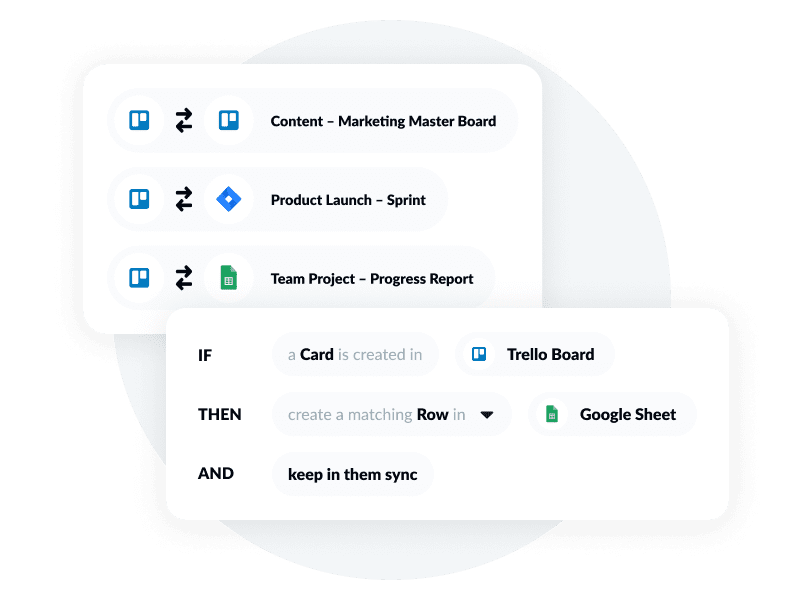
Before you pick an integration solution, you need to know if it’s going to support the tools you use every day.
Exalate currently offers prebuilt integrations for six tools: Jira, Azure DevOps, GitHub, Zendesk, ServiceNow and Salesforce. That means developers, customer support teams, and salespeople can expect Exalate to support their tool of choice — usually.
So what about Unito?
Unito supports connectors for ~50 of the most popular software tools on the market today. In addition to the tools mentioned at the top of this article, the leading 2-way sync platform also integrates with Google Calendar, ClickUp, Airtable, HubSpot, Google Analytics (GA4), Facebook Ads Manager, Google Ads, Confluence, Eloqua, Snowflake, PostgreSQL, Xero, Stripe, Jotform, Typeform, and SurveyMonkey.
Whether it’s a project management tool, spreadsheet, calendar, form, CRM, marketing analytics tool, or a customer support platform, Unito has an integration for it.
Winner: Unito
Depth of integration
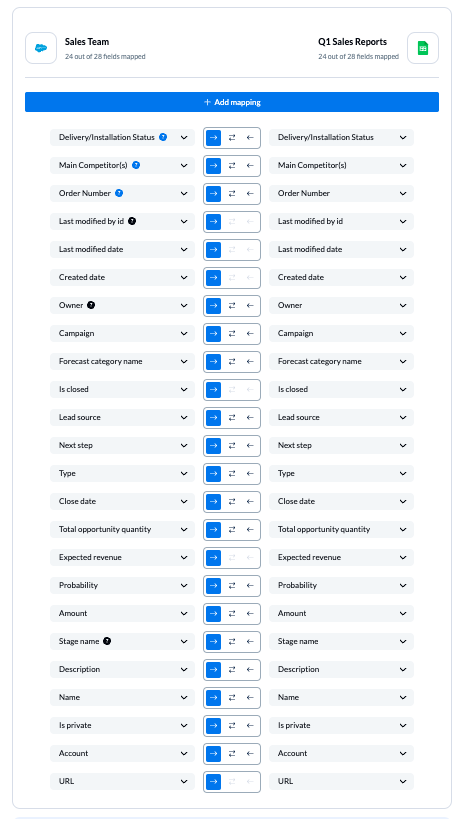
Both Unito and Exalate unite disparate tools using each app’s built-in API, but how many fields can they each support?
It depends.
That’s because both Exalate and Unito can only sync the fields made available through a tool’s API. Subtle differences in how each connector then syncs data can make some fields unavailable.
For instance, Exalate’s Zendesk integration can sync 14 fields, including ticket summaries, attachments, and labels. Meanwhile, Unito can sync more than 20 Zendesk fields.
And don’t forget, there’s the low-code vs. no-code consideration to make. Do you want to configure fields like this?

Or like this?
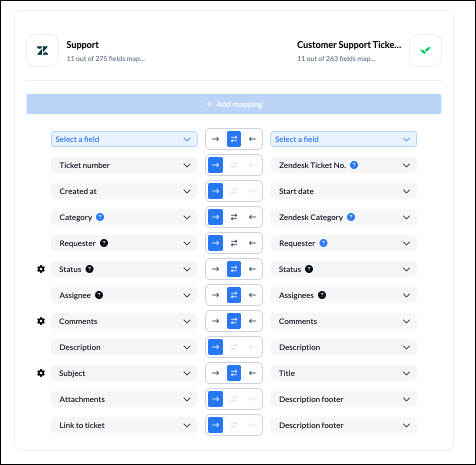
But if we look at Jira, Exalate’s integration can sync over 40 fields while Unito’s integration supports 34.
So, depending on the integration, sometimes Exalate has deeper support, while Unito takes the lead for others. Although if it doesn’t support a native field you need, Unito supports syncing custom fields.
Winner: Tie
Potential use cases
Exalate was built with a focus on customer support and software development from day one. Its name even refers to one of the most common workflows spanning these two teams: support ticket escalation. That’s why its integrations are exclusively platforms that are used in these workflows — except for Salesforce, which is a bit of an outlier here.
Conversely, while Unito started with a similar focus — uniting development teams with project managers — the platform has since grown to encompass more teams and more types of work. Its integrations for spreadsheets unlock automated reporting, while integrations for calendar apps mean you can know exactly where you’re needed no matter what tool you’re in. Integrations for platforms like ServiceNow and Azure DevOps allow for the automation of ticket escalation and agile development workflows as well.

It’s hard to support different use cases with only six integrations unless those are exactly the tools you need to connect. Meanwhile, Unito is a platform that anyone in your organization can benefit from across departments.
Winner: Unito
Synchronization vs. automation
When we talk about automation, we’re referring to the concept of “if this, then that.” Most automation platforms rely on a series of triggers and actions to enable data syncing. This is usually accomplished via scripting as described above.
The integration market is full automation solutions: tools that push data in one direction. That means there are no data updates without a significant investment in manually building complex chains of automations. Tools like Zapier, Tray.io, and Workato are popular examples of this approach.
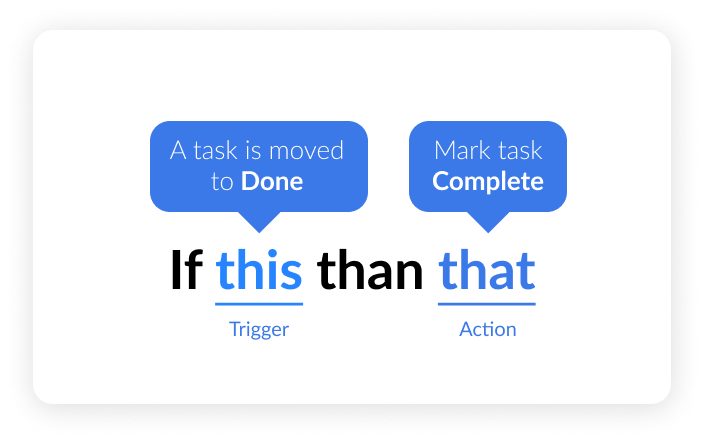
It’s actually not the same thing as integration or 2-way sync. Unito keeps integrations simple in a way that can’t be matched by triggers and actions due to the simple nature of the flow builder and a simple, clickable drop-down interface.
“Do more with less” isn’t just a cliche
For example, to achieve the same impact as a single Unito flow between Asana and Jira, you’d need to create sixteen triggers and actions. Bear in mind it takes the average user as long to set up one flow as only a handful of those triggers.
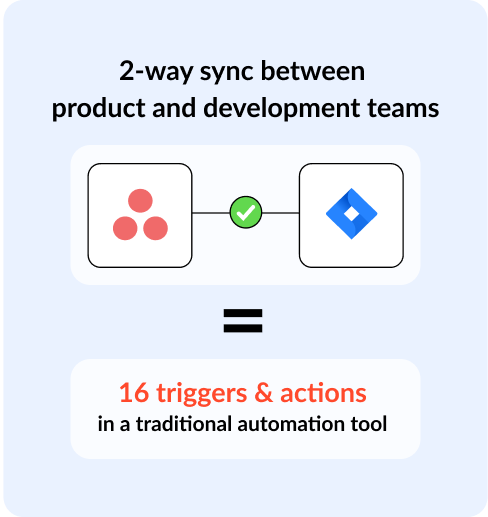
Now imagine scaling that configuration to include multiple tools, projects, or additional fields within your original setup. Without a no-code syncing platform, one org could easily have to create 90-100 recipes to achieve the same real-time communication as a 2-way sync workflow between 5 tools (comprised of 5 flows).
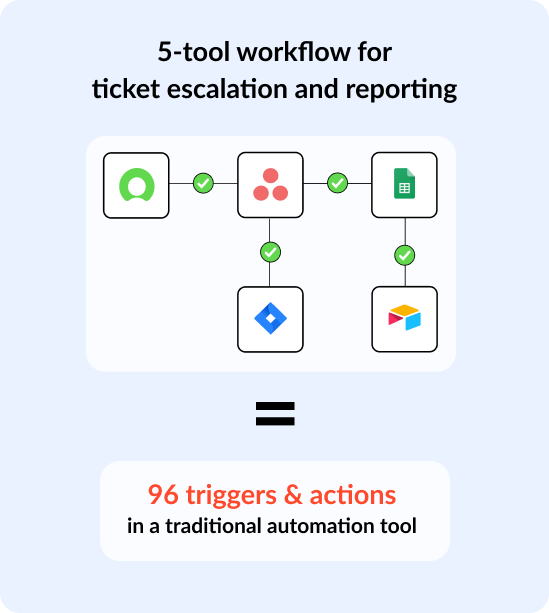
So, do you script and sink? Or toss the script and sync?
Both Unito and Exalate are platforms that allow for two-way syncing of data between tools. Connect two tools and new work items will automatically be created in one whenever you create them in the other. Any updates will be synced as well, meaning each tool is a perfect glimpse into your overall workflow — not just the work happening in that tool.
But while both tools let you sync data in both directions, the difference lies in how it’s done and how much time you spend doing it.
With Exalate, writing scripts is essential for getting the most out of the platform. That’s not something you can set up without coding knowledge, familiarity with Groovy, and a lot of time on your hands. So you’ve already created a bottleneck in your organization for anyone else who wants to sync data or set up their own Exalate workflows.
Meanwhile, Unito’s visual interface enables anyone to connect tools easily without requiring dev time or maintenance.
Winner: Unito
Integrated retry or manual troubleshooting
Even the best integration platforms run into hiccups from time to time. The difference is made in how these issues are handled. Some tools will only throw up warnings when they break, expecting you to dive in and figure out what went wrong. Other platforms will allow you to pause your automations to go back through a log of errors to find the exact issue.
Both Unito and Exalate automatically retry a sync before any troubleshooting is required, meaning that many issues can be resolved without user intervention.
Winner: Tie
Unito vs. Exalate: Pricing
By this point, you may be falling on one side of this divide or the other. But before you make your decision, it’s important to know just how much you can expect to pay for your integration solution of choice.
Exalate
Exalate offers a free plan, which you can use to set up basic syncs between your tools. These syncs are pre-built, meaning you won’t be able to configure how they sync data or build any scripts of your own. This can be a great way to get started but will limit what you can actually do.
If you want full access to the Exalate platform, you need to pay for each tool you’re using Exalate on. So if you’re using Exalate to sync Jira issues with Zendesk tickets, you’ll pay two separate fees. Here’s how much Exalate costs for each platform:
- Jira: $6/month.
- GitHub: $115/month.
- Zendesk: $115/month.
- Salesforce: $335/month.
- Azure DevOps: $335/month.
- ServiceNow: Exalate doesn’t make pricing for this integration available on their website. You’ll have to contact their sales team for an exact quote.
Remember that you’ll pay at least two of these fees each month to use Exalate. That means the minimum you can expect to pay is $121 a month.
Unito
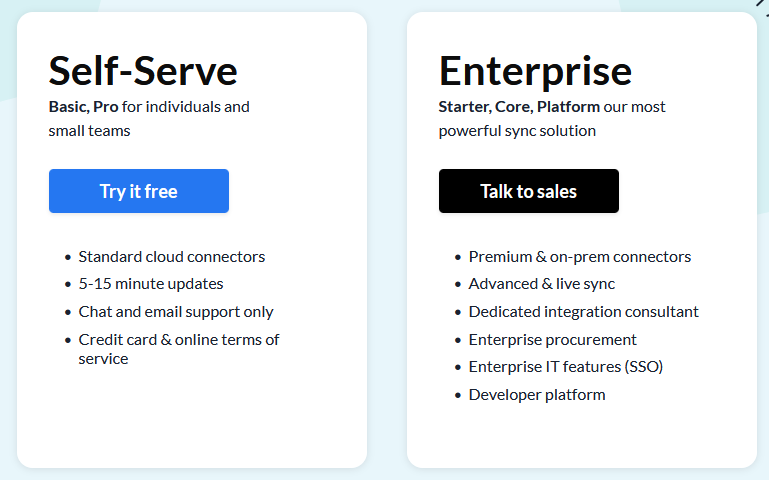
Unito doesn’t offer a free plan, but you’ll only be charged a single fee to get access to the platform. No doubling up on price.
Unito offers two types of plans: Self-Serve and Enterprise. The former category is best for individuals who need to integrate their own personal tools and small teams who don’t have to sync hundreds of work items. Enterprise plans are designed specifically for large teams that need seamless integration throughout their tool stack.
Unito doesn’t offer a free plan, but you can try it free for 14 days. If you want more information on Unito’s pricing and what it can do for your workflows, you can book a demo with our sales team.
When it comes to price, ask yourself if the tool you want fits your budget, but also how much you’re getting for what you’re paying.

Unito vs. Exalate: Security
Both Unito and Exalate take this seriously, offering robust security features to safeguard your information. These include:
- Two-way data encryption
- OAuth2-based authentication
- HTTPS-encrypted traffic
Additionally, Unito prioritizes data security and privacy with measures like SOC 2 Type 2 Compliance and adherence to major data protection regulations (GDPR, CCPA, etc.).

Exalate outlines security policies on their website, and recently achieved ISO27001 certification.
Unito vs. Exalate: Which one’s right for you?
If you just want to optimize workflows between customer support teams and developers, then Exalate might be the best option for you. Just keep in mind that you’ll need someone to code in Groovy to setup and maintain your integrations.
But if you want a platform that anyone can use, with documentation to help you get started, live support, and integrations for every team in your organization, then Unito is a natural choice. You won’t need a developer to deploy it, and its growing list of integrations means that everyone can find a use for it.
Still unsure? Check out this comparison guide for Albato, another Unito alternative.
Best use cases for Unito integrations
Unito is a powerful two-way sync platform supporting ~50 integrations that anyone can set up. Whether you’re an IT Ops leader, project manager, a software developer, a product manager, or even head of a marketing team, there are a range of ways Unito can support your business objectives.
Streamline incident management in IT workflows
Any incident management process in an enterprise organization likely relies on a considerable amount of manual work. Whether your IT team is handling internal requests or customer support escalations, they’ll need to copy and paste details back and forth between tools, emails, or messages on a daily basis without integration.
That’s where Unito’s integration for ServiceNow and Azure DevOps comes in handy:
A request that starts in ServiceNow can be automatically synced to Azure DevOps, where IT teams and developers can start working on it. Updates, questions, and more are synced in both directions, keeping communication lines open without lengthy email threads.
Curious to see how this works? Check out our full guide to incident management between ServiceNow and Azure DevOps.
Automate feature request management
Signing new customers is always exciting. But when those new contracts come with expected development time — for new features or fixing critical bugs — they can create headaches, too. Soon, coordinating that development work can stifle the impact of signing a new big customer.
Unito’s integration for ServiceNow and Salesforce allows the teams that win the deal and those that do the technical work required on the backend to collaborate without compromise. With a single Unito flow, you can automatically sync data bidirectionally between ServiceNow and another tool, keeping everyone in the loop without relying on complex implementations or consultants.
Here’s a closer look at Unito’s use case to connect Salesforce and ServiceNow.
Link your code repository to your Jira projects
Most of the people in your software teams never check in to tools like Jira. They work in their code editor of choice, submit their work to a version control tool like GitHub, and get all the input they need from colleagues there before they finish up that work.
But for product managers and team leads who use Jira to plan their roadmap and manage priorities, that can create a significant lack of visibility that can make managing projects more complicated.
Using Unito, these teams can integrate Jira with version control tools like GitHub to collaborate more efficiently without hopping back and forth between tools.



